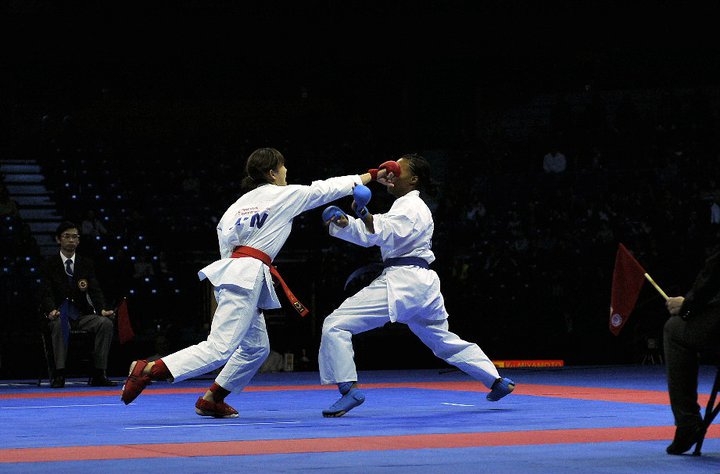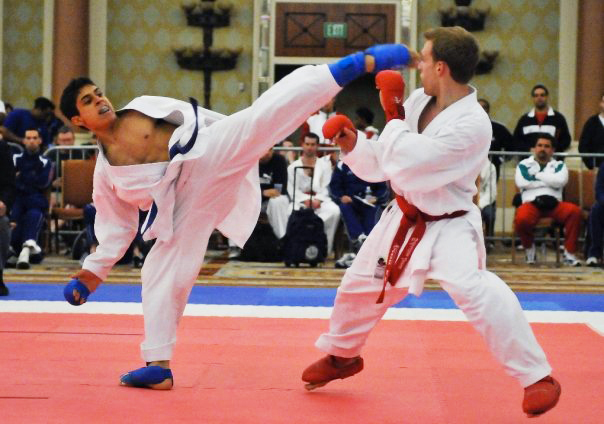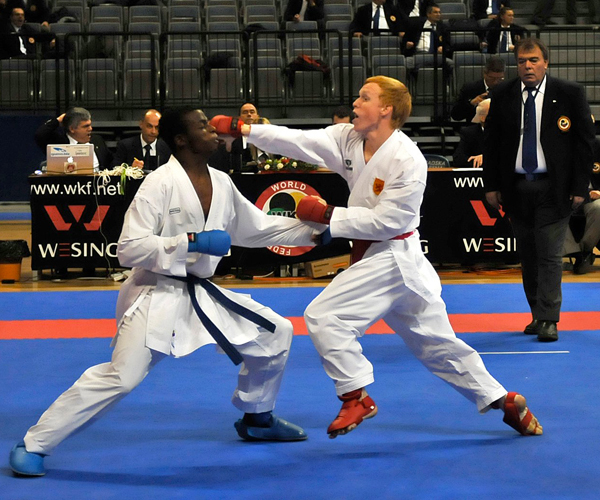Technical details
Here is some information about important technical details on attacks. See also the page Basic concepts for complementary information.
1. Good Technique
To score a point, you need to have a nice technique. You need to have a good reach, and to keep a good balance. You must show to the referees that you can be effective in your strikes.
2. Speed and explosivity
A slow technique cannot score a point. The explosivity is useful to :
- Surprise the opponent
- Create a reaction on the referees behalves
3. Precision on target
4. Kime
Stages of the attack
- Preparation
- Execution
- Exit / Recovery
1. Preparation: the preparation stage allows you to place yourself in a good position to attack. At this stage, you must consider distance, timing and rhythm. If you initiate an attack at the wrong time or with inadequate distance, you will become vulnerable. Be patient before initiating your attack, find the right moment. Attack when the opponent is vulnerable, either physically, mentally or both.
A well-prepared technique is one that is done at a time when the opponent is vulnerable.
 Picture: Courtesy of M. Dick Grant
Picture: Courtesy of M. Dick Grant
The vulnerability of your opponent can be felt (passive) or provoked (active). You will be able to detect this vulnerability only by an intense and constant analysis of your opponent. Let your intuition guide you.
If your opponent is an experienced fighter, there will be few opportunities to attack. Then, you will have no other choice than to create moments where he or she will be vulnerable, with changes in rhythm and feints.
2. Execution: when you make the decision to attack you must take action fast. Don’t hesitate! Use your maximum explosivity and your best technical quality. The desire to score must be high. Do not attack as if you want to do your sequence movement in the air, but focus on your target!
 Picture: Courtesy of M. Dick Grant, Sébastien Larose
Picture: Courtesy of M. Dick Grant, Sébastien Larose
The worst enemy of the attacker is hesitation.
3. The exit: After your technique, it is very important to exit as fast as you came in. When the exit is fast, the technique is clearer for the referees. Futhermore, you stay a shorter period of time in the danger zone and become less vulnerable to your opponent’s counter-attack.
Depending on what the plan is after the attack, there are many exiting options:
- stay at a close distance
- go back and take a larger distance
- sideshift
The most important thing is to be unpredictable and to take advantage of every opportunity.
Defense in attack
During the attack, you should be able to defend yourself at all times. In defense, you should keep an offensive mind. These two concepts (offense/defensive) are closely related in combat. It is also related to the multifunctional mind that we will discuss later on (see multifunctional mind).
Vidéo: This athlete keeps a good defense during his attack.

The adaptative attack
We should be able to change the attack according the opponent’s reactions. We should adjust the distance, targets and trajectories depending on what’s going on in the fight.
If the opponent intercept your attack, you should be able to:
- Stop your technique
- Block the counter-attack
- Change your trajectories and find new targets
How to surprise the opponent?
The attacks in sequence
The attack in sequence allows you to reach a greater distance to score a point. Futhermore, it allows you to create openings in the opponent’s guard.
 Picture: Courtesy of M. Dick Grant
Picture: Courtesy of M. Dick Grant
Try to decrease your vulnerability between the techniques. You should attack with fluidity and decrease the time between each technique. Initiate your attack at the right time, that is, when the opponent is vulnerable. Listen to your heart, you will feel that moment!
- Decrease the openings in the guard during the attack sequence.
- Decrease the time between the techniques.
- Be unpredictable:
- by a surprising initiation of the sequence
- by a good variety of techniques
- by changing the distance you reach
Never forget the main objective, aim at the target!
The efficiency rate of the attacks
It is important to increase your attacks’ efficiency rate. Be rigorous in your timing and choose the techniques wisely. Striking without a good preparation increases your vulnerability.
 Picture: Courtesy of M. Dick Grant
Picture: Courtesy of M. Dick Grant
Exercise: look at your last fights on video. Count the number of techniques you threw to your opponent. Divide that number by the number of points you scored. You will get your percentage of efficiency. Can you get better?
If you are doing a lot of techniques but never scoring, try to find out what the problem is:
- Lack of precision?
- Poor technical quality?
- Are you using the wrong technique at the wrong time? Are you taking wrong decisions?
- Lack of intensity, power or will?

 0
0